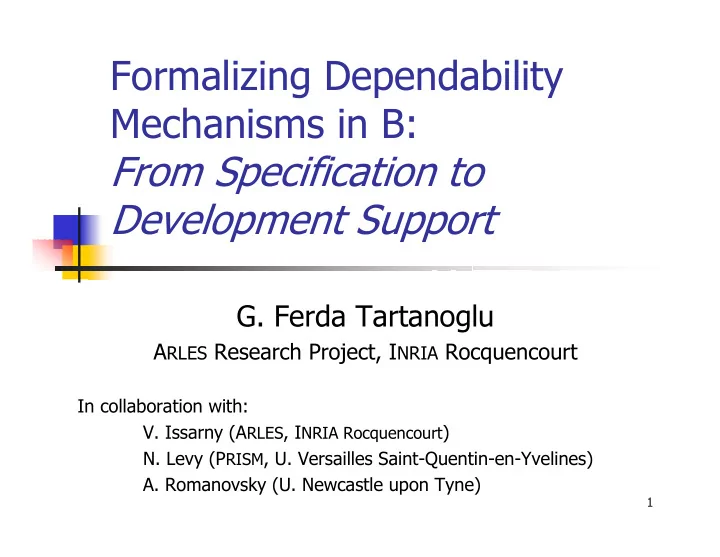

Formalizing Dependability Mechanisms in B: From Specification to Development Support G. Ferda Tartanoglu A RLES Research Project, I NRIA Rocquencourt In collaboration with: V. Issarny (A RLES , I NRIA Rocquencourt ) N. Levy (P RISM , U. Versailles Saint-Quentin-en-Yvelines) A. Romanovsky (U. Newcastle upon Tyne) 1
Introduction � We formalize the notion of Coordinated Atomic Actions using the B method � Validate dependability mechanisms � Transactional access to external objects � Coordinated Exception Handling � Atomicity � Provide an XML-based declarative language for building dependable systems � The B formal specification is refined to obtain an implementation of the associated runtime support 2
Architecting Dependable Systems with Coordinated Atomic Actions 3
Coordinated Atomic Actions � Coordinated Atomic Actions (J. Xu, B. Randell, A. Romanovsky et al., 1995) � Structuring mechanism for developing dependable concurrent systems � Atomic actions : for controlling cooperative concurrency � Coordinated error recovery using exception handling � Transactions : coherency of shared external resources 4
CA Actions Composition Allows the design of distributed systems built out of several CA � actions [Tartanoglu et al., ICSE-WADS 2002] 5
Specifying CA Actions in B � Offer a general framework that can be instantiated to describe the implementation of a specific system that is developed using CA actions � Dependability properties associated with CA actions will be enforced for any system based on them 6
The B Method � A model-based (state-based) method built on set theory and predicate logic and extended by generalized substitutions � Specifications are represented by abstract machines � A machine encapsulates operations and states � Set of variables 7
Refinement in B Abstract specification Machine Refinement step 1 Refinement 1 Refinement step 2 Refinement 2 Refinement step 3 Implementation Implemen- tation 8
Proofs � In B, we prove that � All operations preserve the invariants of the machine � Implementations and refinements preserve the invariant and the behavior of the initial abstract machine 9
B Tools � Atelier B (ClearSy, France) � B-Toolkit (B-Core, UK) � Both tools include � type checker � animator � proof obligation generator � theorem prover � code translators � documentation facilities 10
Modelling CA Actions � Structure of the B specification CONSTANTS SEES PARTICIPANTS OBJECTS EXTENDS CAACTIONS with composition http://www-rocq.inria.fr/~tartanog/dsos/ 11
States and Operations CAACTIONS abstract machine attributes � � CAACTION_STATE={caa_normal,caa_exceptional} � caaction_state ∈ caaction → CAACTION_STATE � participant_of_caaction ∈ caaction → P (participant) � caaction_of_participant ∈ participant → seq (caaction) � caaction_ext_objects ∈ caaction ↔ objects Pre-conditioned operations � � create_{main,nested,composed}_caaction � {send,recv}_message � {read,write}_object(participant,participant,message) � raise_exception(participant,exception) � propagate_exception(participant) � abort_{main,nested,composed} (caaction) � terminate_{main,nested,composed} (caaction) 12
Formalizing Dependability Mechanisms � Transactions on external objects � Atomicity of CA Actions � Coordinated exception handling 13
Transactions on External Objects � Participants setpar of nested CA action caa1 can only access subset setobj of external objects associated to containing CA action caa2 � ∀ obj.(obj ∈ setobj ⇒ obj ∈ caaction_ext_objects[{caa2}]) 14
Atomicity of CA Actions Participants of nested CA action caa1 are also participants of � containing action caa2 � ∀ (caa1,caa2).((caa1 ∈ caaction Λ caa2 ∈ caaction Λ (caa1,caa2) ∈ is_nested ) ⇒ participants_of_caaction(caa1) ⊆ participants_of_caaaction(caa2)) A participant can only enter one sibling nested CA action at a � time � card ( ran ({p,c | p ∈ setpar Λ c ∈ CAACTION Λ c= last (caaction_of_participants(p))})) = 1 15
Coordinated Exception Handling � A CA action is set to an exceptional state if all of its participants are in the exceptional state � ∀ (caa). (caa ∈ caaction Λ caaction_state(caa)=caa_exceptional ⇒ ∀ (p).(p ∈ participant_of_caaction(caa) ⇒ ( last (participant_state(p)) ∈ EXCEPTIONAL_STATE))) 16
From the B Specification to the Development Support 17
Refinement � In order to have an implementation of the CA action’s runtime support, the abstract machines are refined � B operations offered as a programming library � Existing libraries are used � To be able to prove the correctness of the implementation � Formal specification of the behavior of these methods � Prove that the refinement of the machines that use these methods are correct 18
Declarative Language � XML-based declarative language for building CA action-based systems < caaction name =“nmtoken”? > < composedActions > ? < action name =“qname” /> * </ composedActions > < nestedActions > ? < nested name =“nmtoken” /> * </ nestedActions > < external > ? < object name =“nmtoken” /> * </ external > 19
Participant Behavior < participants > < participant name =“nmtoken”> + < var > < element name =“nmtoken” type =“qname”/> * </ var > < behavior > < normal > statements … </ normal > < exceptional handle =“qname”> * statements … </ exceptional > </ behavior > </ participant > </ participants > 20
Statements < invoke action =“qname” input =“qname”? output =“qname”?/> � create_composed < send rcpt =“qname” input =“qname”/> � send_message < recv from =“qname” output =“qname”/> � recv_message < call rcpt =“qname” input =“qname” output =“qname” /> � {read,write}_object < assign element =“qname” value =“xpath”/> � set_value < raise exception =“qname” message =“qname”? /> � raise_exception < nest nestedaction =“qname”? > behavior … </ nest > � create_nested 21
Future Work � Development support � Implementation of a compiler/code generator for the declarative language � Extend the base CA Action model using the formal model � Already used to introduce CA Action composition � Relax atomicity properties 22
Web Services Composition Actions � Relaxes the transactional requirements over external interactions � Relaxed atomicity � Compensations when available : semantic atomicity 23
Recommend
More recommend